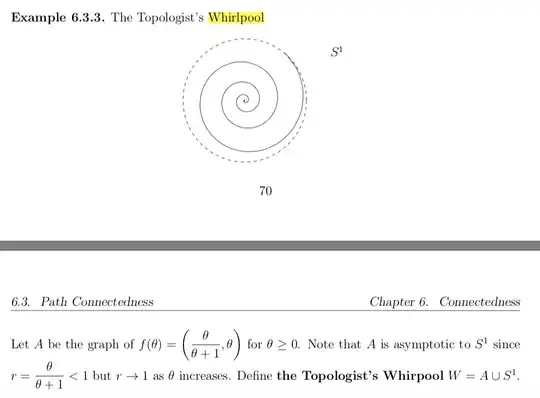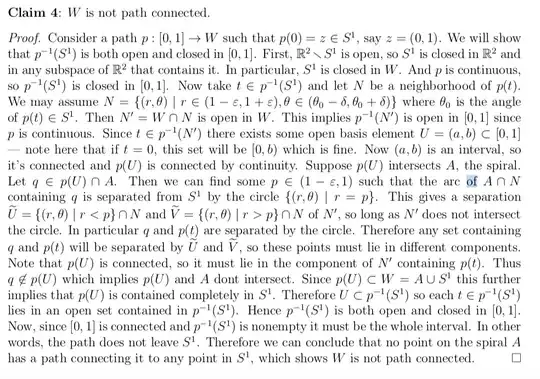Let $u:[0,1]\to W$ be continuous with $u(0)\in S^1.$
For any $x\in [0,1]$ such that $u(x)\in S^1$ we may take an open disk $E_x$ in $\Bbb R^2,$ centered at $u(x), $ of sufficiently small radius that for any $p\in E_x\cap (W\setminus S^1)$ there exist $disjoint$ open subsets $U_{p,x}, V_{p,x}$ of $\Bbb R^2$ such that $$(*)\quad u(x)\in U_{p,x}\;\land \; p\in V_{p,x}$$ and such that $$(**)\quad U_{p,x}\cup V_{p,x}\supset E_x\cap W.$$ There exists $d_x>0$ such that $J(x)=\{u(y): y\in [0,1]\cap (-d_x+x,d_x+x)\} \subset E_x.$ Now $[0,1]\cap (-d_x+x,d_x+x)$ is connected and $u$ is continuous, so $J(x)$ is connected. But if $p\in J(x)\setminus S^1$ then by $(*)$ and $(**),\; $ $J(x)$ would not be connected.
Therefore no $p\in E_x\cap (W\setminus S^1)$ belongs to $J(x).$ So, with $I(x)=[0,1]\cap (-d_x+x,d_x+x),$ we have $I(x)\subset u^{-1}S^1.$
Therefore $u^{-1}S^1=\cup \{I(x): u(x)\in S^1\}$ is OPEN in the space $[0,1].$ But $S^1$ is closed in $W$ and $u$ is continuous so $u^{-1}S^1$ is CLOSED in $[0,1].$
So $u^{-1}S^1$ is open-and-closed in the connected space $[0,1]$ and is not empty (because $0\in u^{-1}S^1).$ So $u^{-1}S^1=[0,1].$ So $u$ cannot be a path from $u(0)$ to any member of $W\setminus S^1.$
Remark: If the radius of $E_x$ is small enough, and if $p=f(\theta)=\frac {\theta}{1+\theta}(\cos \theta,\sin \theta)\in E_x\cap (W\setminus S^1),$ (with $\theta \in [0,\infty)\,),$ then there exist $t,t'$ with $\theta<t<t', $ such that $f(t)$ and $f(t')$ lie on the boundary (in $\Bbb R^2)$ of $E_x,$ and such that $f(\psi)\not \in E_x$ for $t<\psi<t'.$ Then the sets $\{f(z): z\in [0,t]\}$ and $S^1\cup \{f(z):z\ge t'\}$ are closed and disjoint in $\Bbb R^2,$ so they are completely separated by some disjoint open $U_{p,x},V_{p,x}$ that will (automatically) satisfy $(*)$ and $(**)$.

